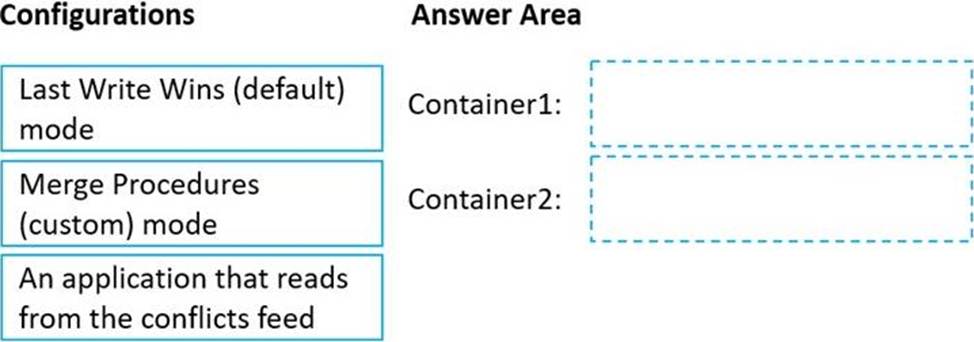Practice Free DP-420 Exam Online Questions
DRAG DROP
You have an Azure Cosmos DB Core (SQL) API account that is configured for multi-region writes. The account contains a database that has two containers named container1 and container2.
The following is a sample of a document in container1:
{
"customerId": 1234,
"firstName": "John",
"lastName": "Smith",
"policyYear": 2021
}
The following is a sample of a document in container2:
{
"gpsId": 1234,
"latitude": 38.8951,
"longitude": -77.0364
}
You need to configure conflict resolution to meet the following requirements:
For container1 you must resolve conflicts by using the highest value for policyYear.
For container2 you must resolve conflicts by accepting the distance closest to latitude: 40.730610 and
longitude: -73.935242.
Administrative effort must be minimized to implement the solution.
What should you configure for each container? To answer, drag the appropriate configurations to the correct containers. Each configuration may be used once, more than once, or not at all. You may
need to drag the split bar between panes or scroll to view content. NOTE: Each correct selection is worth one point.


Explanation:
Box 1: Last Write Wins (LWW) (default) mode
Last Write Wins (LWW): This resolution policy, by default, uses a system-defined timestamp property.
It’s based on the time-synchronization clock protocol.
Box 2: Merge Procedures (custom) mode
Custom: This resolution policy is designed for application-defined semantics for reconciliation of conflicts. When you set this policy on your Azure Cosmos container, you also need to register a merge stored procedure. This procedure is automatically invoked when conflicts are detected under a database transaction on the server. The system provides exactly once guarantee for the execution of a merge procedure as part of the commitment protocol.
Reference: https://docs.microsoft.com/en-us/azure/cosmos-db/conflict-resolution-policies
https://docs.microsoft.com/en-us/azure/cosmos-db/sql/how-to-manage-conflicts
You have an application that queries an Azure Cosmos 06 for NoSQL account.
You discover that the following two queries run frequently,
![]()
You need to minimize the request units (RUs) consumed by reads and writes.
What should you create?
- A . a composite index for (name DESC, time stamp ASC)
- B . a composite index for (name ASC, time stamp DESC)
- C . a composite index for (name ASC time stamp ASC) and a composite index for (name, time stamp disc)
- D . a composite index for (name ASC, time stamp ASC)
You plan to create an Azure Cosmos DB account that will use the NoSQL API.
You need to create a grouping strategy for items that will be stored in the account. The solution must ensure that write and read operations on the items can be performed within the same transact!
What should you use to group the items?
- A . logical partitions
- B . physical partitions
- C . databases
- D . containers
